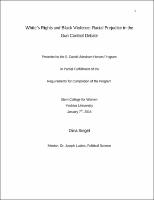Please use this identifier to cite or link to this item:
https://hdl.handle.net/20.500.12202/4065Full metadata record
| DC Field | Value | Language |
|---|---|---|
| dc.contributor.author | Siegel, Dina | - |
| dc.date.accessioned | 2018-11-05T20:54:09Z | - |
| dc.date.available | 2018-11-05T20:54:09Z | - |
| dc.date.issued | 2016-01 | - |
| dc.identifier.uri | https://hdl.handle.net/20.500.12202/4065 | - |
| dc.identifier.uri | https://ezproxy.yu.edu/login?url=https://repository.yu.edu/handle/20.500.12202/4065 | |
| dc.description | The file is restricted for YU community access only. | - |
| dc.description.abstract | Despite highly publicized mass shootings committed by individuals with easy access to guns, national support for gun control has not increased. After the shooting at the Charleston AME church in June, 2015, google trends data found people searched for gun control more than gun shop for three days following the massacre (Ma, A., 2015). Mass shootings spark public interest in gun control in their immediate aftermath, but the effects are followed by a rise in gun purchases (Wallace, 2015). At the same time that mass shootings continue to capture public attention, the national crime rate has been steadily falling, making America objectively safer. Over the past 20 years violent crime has decreased from a rate of 684.5 out of 100,000 people in 1995 to 365.5 out of 100,000 in 2014 (Federal Bureau of Investigation, 2014). Consequently, the decreased need for guns as a means of self-protection might lead to increased support for gun control. Nonetheless, individuals still cite concern about personal safety as their main reason for owning a gun (Gallup, 2015; Sheinwald, Thompson, & Washington, 2014), even though it seems inconsistent with the reality of lower crime. Although the reduction in crime and increased awareness of mass shootings have reduced the apparent motivation for guns, gun sales surged in 2008 (Depetris-Chauvin, 2015). There is thus a puzzle: How can we understand attitudes towards gun control in light of falling crime rates and an increasing number of mass shooting incidents (Krouse & Richardson, 2015)? | en_US |
| dc.description.sponsorship | S. Daniel Abraham Honors Program | en_US |
| dc.language.iso | en_US | en_US |
| dc.publisher | Stern College for Women | en_US |
| dc.rights | Attribution-NonCommercial-NoDerivs 3.0 United States | * |
| dc.rights.uri | http://creativecommons.org/licenses/by-nc-nd/3.0/us/ | * |
| dc.subject | Firearms --Law and legislation --United States. | en_US |
| dc.subject | Firearms --Political aspects --United States. | en_US |
| dc.subject | Gun control --Political aspects --United States. | en_US |
| dc.subject | Racism --Political aspects --United States. | en_US |
| dc.subject | African Americans --Attitudes. | en_US |
| dc.subject | Whites --United States --Attitudes. | en_US |
| dc.subject | Political parties --Platforms. | en_US |
| dc.subject | Resentment. | en_US |
| dc.subject | United States --Race relations --Political aspects. | en_US |
| dc.title | White’s Rights and Black Violence: Racial Prejudice in the Gun Control Debate | en_US |
| dc.type | Thesis | en_US |
| Appears in Collections: | S. Daniel Abraham Honors Student Theses | |
Files in This Item:
| File | Description | Size | Format | |
|---|---|---|---|---|
| Dina-Siegel.pdf Restricted Access | 223.38 kB | Adobe PDF |  View/Open |
This item is licensed under a Creative Commons License

